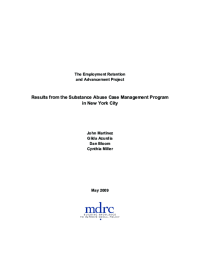Results from the Substance Abuse Case Management Program in New York City
The Employment Retention and Advancement Project
This report presents implementation and one-and-one-half-year impact results for the Substance Abuse Case Management (SACM) intervention, a program funded by the New York City Human Resources Administration (HRA) and operated by its contracted vendor, University Behavioral Associates (UBA). SACM provided intensive care management services to public assistance recipients — primarily childless, single adults participating in the New York Safety Net program — who were identified at a welfare office as possibly having a substance abuse issue. SACM services included assessing the nature and severity of the substance abuse, making referrals to substance abuse treatment providers and (when appropriate) to welfare-to-work activities, and facilitating client engagement with all service providers. The goals of SACM were to increase client engagement in treatment and to improve the recovery and employability of participants. The evaluation followed a sample of public assistance applicants and recipients who were referred for a substance abuse assessment from June 2003 to June 2005.
SACM is one of 16 innovative models across the country that MDRC is evaluating as part of the Employment Retention and Advancement (ERA) Project under contract to the Administration for Children and Families (ACF) in the U.S. Department of Health and Human Services, with additional funding from the U.S. Department of Labor for the evaluation of SACM, in which eligible individuals were assigned to one of two groups. Those assigned to the SACM group could receive intensive care management services from UBA. Those assigned to the usual care group received many of the same services provided by UBA but at less intensity and with less coordination. The report’s findings thus indicate whether SACM was more effective than HRA’s regular approach in providing substance abuse case management services.
Key Findings
- The general sequence of services was similar for the SACM group and the usual care group, but the intensity of services was much greater in SACM. Though both groups received initial assessments to determine the nature and severity of the substance abuse, relative to usual care, SACM’s assessment was more intense, was more clinically focused, and was conducted by a psychologist or clinical social worker rather than a Credentialed Alcoholism and Substance Abuse Counselor. In addition, the level of staff interaction with SACM clients was greater, due to smaller caseloads (anywhere from one-half to two-thirds the caseload in usual care) and a less fragmented approach. Case management services to encourage treatment retention were especially intensive in SACM relative to usual care, where case management was virtually nonexistent.
- Compared with the usual care group, the SACM group was slightly more likely to be referred to, and to enroll in, substance abuse treatment. In addition, the SACM group was more likely to be referred to employment services. SACM was somewhat more successful in linking clients to substance abuse treatment — an important first step. This improvement could be due to an increase in the number of clients whom SACM found to be in need of treatment relative to the number identified in usual care and/or to the more intensive services provided by SACM. SACM also led to a small increase — 3.1 percentage points above the control group level of 40.8 percent — in the proportion of clients referred to HRA employment programs.
- During the 1.5-year follow-up period, SACM had no effect on employment and benefits receipt for the full sample. There was no increase in the proportion of the SACM group who were employed relative to the usual care group. SACM did lead to a reduction in benefits receipt for the subgroup who received Temporary Assistance for Needy Families (TANF).
MDRC will continue to track the employment paths of both the SACM and the usual care group and will present longer-term results in the future.






